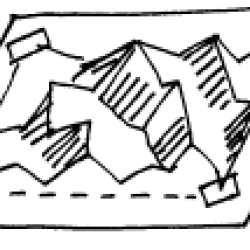Source Institutions
Source Institutions
Add to list Go to activity
Activity link broken? See if it's at the internet archive

In this activity (on pages 36-39), learners make a model of a watershed out of paper, then run water down the mountain to simulate how rainfall and pollution affect watersheds. Learners are introduced to the ABCs of runoff—how agricultural runoff, bulldozers, chemicals and human debris impact lakes, streams and rivers in urban as well as suburban areas. Water-soluble colored markers are used to represent rivers and these pollution sources. The "Think It Over" section at the end encourages learners to reflect on what they wash down their drains at home.
- 10 to 30 minutes
- 10 to 30 minutes
- $1 - $5 per group of students
- Ages 8 - 14
- Activity, Model, Simulation
- English, Spanish
Quick Guide
Materials List (per group of students)
- 2 sheets of 8 1/2 x 11 bond paper
- water-soluble pens in green, yellow, red, brown, blue
- tape
- spray bottle of water
- pen or thin permanent marker
- paper towels
Subjects
-
Earth and Space Science
-
Earth Structure
- Oceans and Water
-
Earth Structure
-
Life Sciences
-
Ecology
- Ecosystems
- Human Impact
-
Ecology
Informal Categories
- Model Building
- Nature and Environment
Audience
To use this activity, learners need to:
- see
- see color
- touch
Learning styles supported:
- Involves teamwork and communication skills
- Uses STEM to solve real-world problems
- Involves hands-on or lab activities
Designed specifically for
- Rural dweller
Culture, ethnicity, and gender
-
Girls
- Explicity developed for this group
Other
Foreign language versions of this resource:
Components that are part of this resource:
Includes alignment to state and/or national standards:
This resource is part of:
Access Rights:
- Free access
By:
Source Collection
- Science After School Consumer's Guide
Rights:
- , University of Nebraska State Museum and Nebraska 4-H, 2001
Funding Sources:
- National Science Foundation Informal Science Education Program, 9909496
- Howard Hughes Medical Institute
